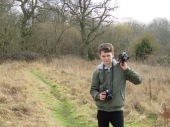As the landscape opens up across fenland, shallow ponds and sandy cliff faces, I’m stood where there was once a warm, shallow sea full of coral, in an area that would have had a temperature similar to the Caribbean.
Dry Sandford Pit was a working quarry up until late 1950’s, being excavated for its sand. The steep cliffs of sand, full of fossils, are now home to hundreds and hundreds of tiny holes made by solitary bees and wasps.
The deepest parts of excavation are now flooded making marshy habitats and large, shallow ponds, which on the day I visited was only occupied by Mallard ducks, but I imagine in the summer months it will be home to butterflies, dragonflies and other insects.
Spring flowers are just appearing, as we left the car park a large patch of Primroses are tucked under small trees and Violets grow at the base of the cliffs.
A Buzzard passed overhead arguing with a gang of rooks, and two Red Kites circled high on the rising late afternoon thermals.
As we walked around the edge of the reserve we found signs of Badgers, foxes and deers. A Muntjac crept through the reeds trying to avoid us and as we wandered along the top edge we startled two hares that ran and disappeared under a patch of brambles.
Before we left we sat on a bench for a while opposite one of the cliff faces watching rabbits hopping in and out of their sandy burrows while a squirrel leapt from tree to tree above our heads.























Pingback: BBOWT – Hitchcopse Pit | Appleton Wildlife Diary by Alex White
what is the red thing? – excuse the ignorance
LikeLiked by 1 person
It’s a type of fungi called a Scarlet Elf cup. They are one of my favourites.
LikeLike
oh thanks. i will look out for them
LikeLiked by 1 person
Excellent post Alex! I remember visiting this reserve for my birthday last August, it looked very different than it does now however I can still recognise the places that you photographed. I can recall the large numbers of solitary bees. One of the highlights was finding my first Agapanthia villosoviridescens on a reed. It is certainly an amazing place to visit at any time of year but especially summer; the invertebrate diversity is impressive.
LikeLiked by 1 person
I’m looking forward to going back in the summer and spending some time there as it’s only 10 minutes from my house
LikeLike
Looks like some good solitary bee habitats there?
LikeLiked by 1 person